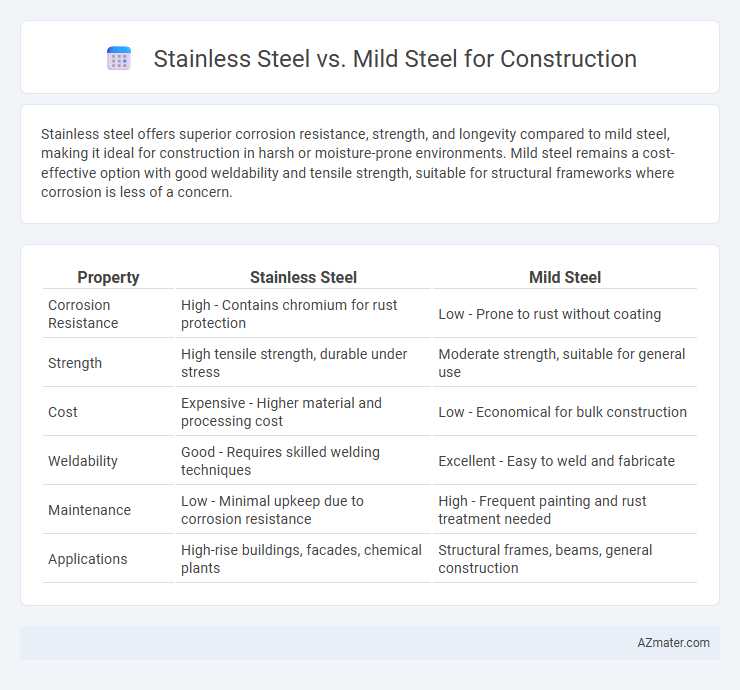Stainless steel offers superior corrosion resistance, strength, and longevity compared to mild steel, making it ideal for construction in harsh or moisture-prone environments. Mild steel remains a cost-effective option with good weldability and tensile strength, suitable for structural frameworks where corrosion is less of a concern.
Table of Comparison
| Property | Stainless Steel | Mild Steel |
|---|---|---|
| Corrosion Resistance | High - Contains chromium for rust protection | Low - Prone to rust without coating |
| Strength | High tensile strength, durable under stress | Moderate strength, suitable for general use |
| Cost | Expensive - Higher material and processing cost | Low - Economical for bulk construction |
| Weldability | Good - Requires skilled welding techniques | Excellent - Easy to weld and fabricate |
| Maintenance | Low - Minimal upkeep due to corrosion resistance | High - Frequent painting and rust treatment needed |
| Applications | High-rise buildings, facades, chemical plants | Structural frames, beams, general construction |
Introduction to Stainless Steel and Mild Steel in Construction
Stainless steel in construction is prized for its corrosion resistance, durability, and low maintenance, making it ideal for structures exposed to harsh environments. Mild steel, commonly used due to its affordability and tensile strength, offers ease of welding and forming but requires protective coatings to prevent rust. Comparing stainless steel and mild steel highlights the trade-off between long-term performance and initial cost efficiency in construction projects.
Chemical Composition and Material Properties
Stainless steel contains a higher percentage of chromium (typically 10.5% or more) and often nickel, providing excellent corrosion resistance and enhanced durability, making it ideal for environments exposed to moisture or chemicals. Mild steel, composed primarily of iron with a small carbon content (usually 0.05-0.25%), offers good strength and ductility but lacks corrosion resistance, requiring protective coatings for longevity in construction. The material properties of stainless steel include superior tensile strength, hardness, and resistance to oxidation, while mild steel provides better weldability and is more cost-effective for structural applications.
Strength and Structural Performance
Stainless steel offers superior strength and corrosion resistance compared to mild steel, making it ideal for long-lasting structural applications where durability is critical. Mild steel provides adequate strength for standard construction needs but requires protective coatings to prevent rust and degradation over time. Structural performance is enhanced with stainless steel due to its high tensile strength and resistance to deformation under load, whereas mild steel may need additional maintenance and reinforcement in harsh environments.
Corrosion Resistance and Durability
Stainless steel offers superior corrosion resistance in construction due to its chromium content, which forms a passive oxide layer preventing rust and deterioration even in harsh environments. Mild steel, while cost-effective, is prone to rust and requires protective coatings or maintenance to ensure durability over time. The enhanced corrosion resistance of stainless steel significantly extends the lifespan of structural components, making it ideal for applications exposed to moisture or chemicals.
Cost Comparison and Economic Considerations
Stainless steel offers superior corrosion resistance and durability compared to mild steel, resulting in lower maintenance costs over the lifespan of a construction project. Although the initial material cost of stainless steel can be three to five times higher than mild steel, its extended durability and reduced replacement frequency often lead to better long-term economic value. Mild steel remains popular for budget-sensitive projects due to its lower upfront cost, but the total cost of ownership must account for potential expenses from rust prevention and structural repairs.
Fabrication and Ease of Installation
Stainless steel offers superior corrosion resistance and strength, making it ideal for fabrication requiring durability and minimal maintenance, while mild steel is easier to cut, weld, and machine due to its lower hardness. Fabrication of mild steel is generally faster and more cost-effective, but stainless steel's resistance to deformation and wear ensures longer-lasting installations in harsh environments. Ease of installation favors mild steel for straightforward projects, though stainless steel reduces future repairs and replacements, providing long-term value.
Maintenance Requirements and Longevity
Stainless steel offers superior corrosion resistance and requires minimal maintenance compared to mild steel, which is prone to rust and frequently needs protective coatings or repairs. The longevity of stainless steel in construction is significantly higher, often exceeding 50 years without significant degradation, while mild steel structures typically last 20-30 years under standard conditions. Choosing stainless steel reduces lifecycle costs due to fewer repairs and replacements, enhancing structural durability and safety.
Environmental Impact and Sustainability
Stainless steel offers superior corrosion resistance and a longer lifecycle, reducing the need for frequent replacements and lowering environmental impact compared to mild steel. Mild steel, while cheaper and more energy-efficient to produce, requires protective coatings that can degrade over time, increasing maintenance and environmental costs. Recyclability rates are high for both materials, but stainless steel's durability supports sustainable construction by minimizing resource consumption and waste over a building's lifespan.
Common Applications in Modern Construction
Stainless steel is widely used in modern construction for structural elements exposed to harsh environments, such as cladding, roofing, and reinforcement in coastal or industrial areas due to its corrosion resistance and durability. Mild steel is preferred for general structural frameworks, beams, and reinforcements where cost efficiency and strength are critical but exposure to corrosive elements is minimal. Combining both materials optimizes performance and budget, with stainless steel often reserved for visible or high-corrosion zones and mild steel for internal or protected structures.
Choosing the Right Steel for Your Project
Stainless steel offers superior corrosion resistance and durability, making it ideal for structures exposed to harsh environments or requiring minimal maintenance. Mild steel provides excellent strength and affordability, suitable for general construction where exposure to moisture and chemicals is limited. Selecting the right steel depends on project requirements, budget constraints, and environmental conditions to ensure longevity and structural integrity.

Infographic: Stainless steel vs Mild steel for Construction
 azmater.com
azmater.com